|

1979 WORLDS
DURBAN / SOUTH AFRICA
RESULTS (top-30 teams) |
PHOTOS
Archives of Richard Crocket & Sailings Publications
|
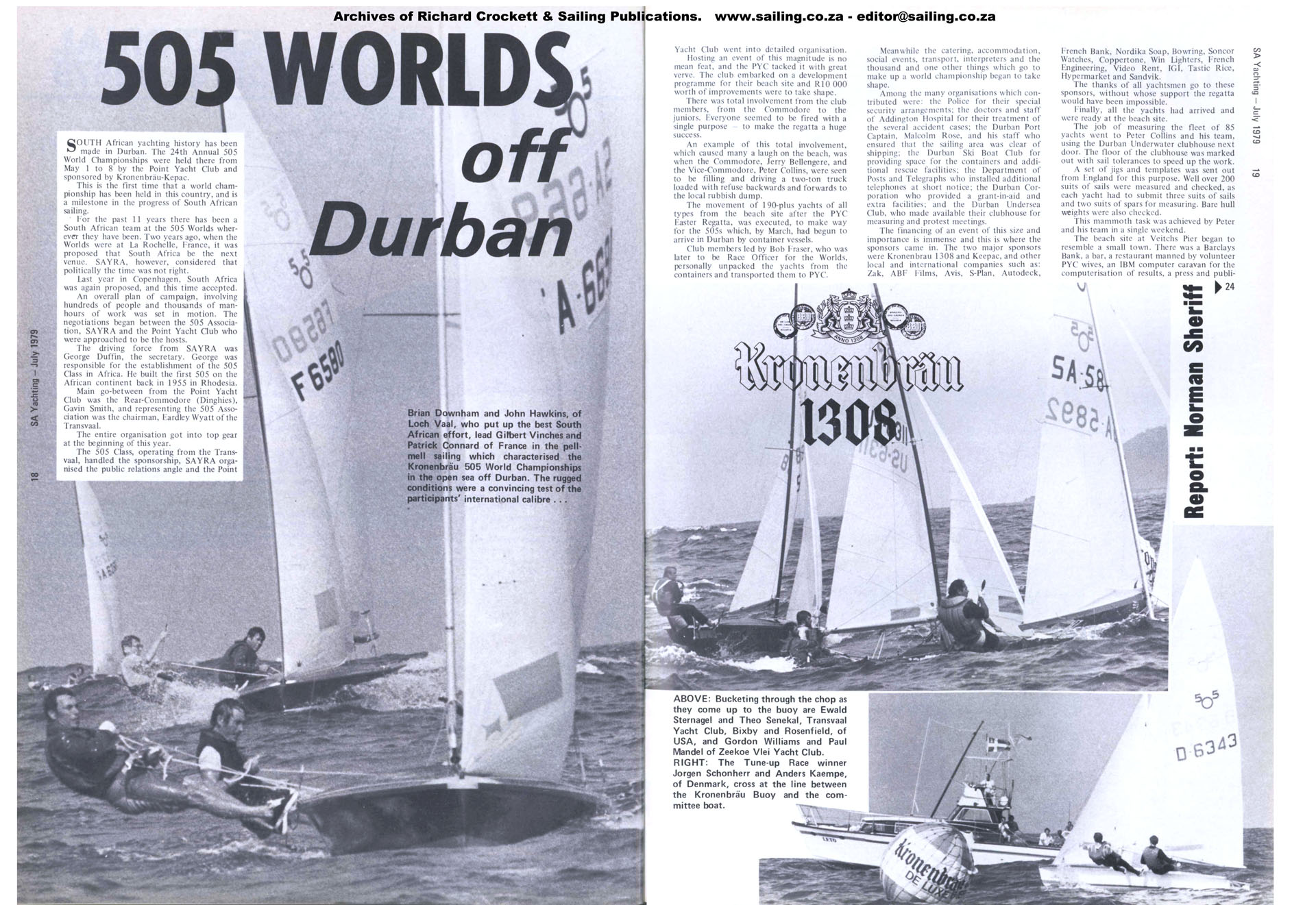 |
SOUTH African yachting history has
been made in Durban. The 24th Annual 505 World Championships were held
there from May 1 to 8 by the
Point Yacht Club and sponsored by
Kronenbrau-Kepac.
This is the first time that a world championship has been held in this
country, and is a milestone in the progress of South African sailing.
For the past 11 years there has been a South African team at the 505
Worlds wherever they have been. Two years ago, when the Worlds were at
La Rochelle, France, it was proposed that South Africa be the next
venue. SAYRA, however, considered that politically the time was not
right.
Last year in Copenhagen, South Africa was again proposed, and this time
accepted.
An overall plan of campaign, involving hundreds of people and thousands
of man-hours of work was set in motion. The negotiations began between
the 505 Association, SAYRA and the Point Yacht Club who were approached
to be the hosts.
The driving force from SAYRA was George Duffin, the secretary. George
was responsible for the establishment of the 505 Class in Africa. He
built the first 505 on the African continent back in 1955 in Rhodesia.
Main go-between from the Point Yacht Club was the Rear-Commodore
(Dinghies), Gavin Smith, and representing the 505 Association was the
chairman, Eardley Wyatt of the Transvaal.
The entire organisation got into top gear at the beginning of this year.
The 505 Class, operating from the Transvaal, handled the sponsorship,
SAYRA organised the public relations angle and the Point Yacht Club went
into detailed organisation.
Hosting an event of this magnitude is no mean feat, and the PYC tacked
it with great verve. The club embarked on a development programme for
their beach site and R10 000 worth of improvements were to take shape.
There was total involvement from the club members, from the Commodore to
the juniors. Everyone seemed to be fired with a single purpose � to make
the regatta a huge success.
An example of this total involvement, which caused many a laugh on the
beach, was when the Commodore, Jerry Bellengere, and the Vice-Commodore,
Peter Collins, were seen to be filling and driving a two-ton truck
loaded with refuse backwards and forwards to the local rubbish dump.
The movement of 190-plus yachts of all types from the beach site after
the PYC Easter Regatta, was executed, to make way for the 505s which, by
March, had begun to arrive in Durban by container vessels.
Club members led by Bob Fraser, who was later to be Race Officer for the
Worlds, personally unpacked the yachts from the containers and
transported them to PYC.
Meanwhile the catering, accommodation, social events, transport,
interpreters and the thousand and one other things which go to make up a
world championship began to take shape.
Among the many organisations which contributed were: the Police for
their special security arrangements; the doctors and staff of Addington
Hospital for their treatment of the several accident cases; the Durban
Port Captain, Malcolm Rose, and his staff who ensured that the sailing
area was clear of shipping; the Durban Ski Boat Club for providing space
for the containers and additional rescue facilities; the Department of
Posts and Telegraphs who installed additional telephones at short
notice; the Durban Corporation who provided a grant-in-aid and extra
facilities; and the Durban Undersea Club, who made available their
clubhouse for measuring and protest meetings.
The financing of an event of this size and importance is immense and
this is where the sponsors came in. The two major sponsors were
Kronenbrau 1308 and Keepac, and other local and international companies
such as: Zak, ABF Films, Avis, S-Plan, Autodeck, French Bank, Nordika
Soap, Bowring, Soncor Watches, Coppertone, Win Lighters, French
Engineering, Video Rent, IGI, Tastic Rice, Hypermarket and Sandvik.
The thanks of all yachtsmen go to these sponsors, without whose support
the regatta would have been impossible.
Finally, all the yachts had arrived and were ready at the beach site.
The job of measuring the fleet of 85 yachts went to Peter Collins and
his team, using the Durban Underwater clubhouse next door. The floor of
the clubhouse was marked out with sail tolerances to speed up the work.
A set of jigs and templates was sent out from England for this purpose.
Well over 200 suits of sails were measured and checked, as each yacht
had to submit three suits of sails and two suits of spars for measuring.
Bare hull weights were also checked.
This mammoth task was achieved by Peter and his team in a single
weekend.
The beach site at Veitchs her began to resemble a small town. There was
a Barclays Bank, a bar, a restaurant manned by volunteer PYC wives, an
IBM computer caravan for the computerisation of results, a press and
publicity caravan, a Wilbur Ellis shop and, of course, the now-famous
Rothmans Caravan containing the communications centre.
The yachtsmen themselves had now started to arrive, mainly Americans and
Australians.
The Pre-worlds Selection Regatta saw 56 yachts take to the water, 31 of
them from overseas. It was apparent that the visitors were, at first, a
little non-plussed at the size of the surf in Durban, but by the end of
the regatta all competitors had learnt to handle this angle.
Four races were held in generally good conditions, and overall results
were: 1, Ethan Bixby (USA); 2, Jon Andron (USA); 3, Roger Down
(Australia): 4, Serge Guillaume (France); 5, John Guilder (Australia);
6, Jim Wondolleck (USA).
The first South African boat was sailed by Rob Wilcox and was placed
seventh.
During the final weekend before the start of the Worlds, all the
competitors arrived in Durban. Many of them were accommodated by PYC
members in their houses.
Altogether there were to be 85 yachts competing from 12 countries. The
number of nations competing was to have been more, but politics raised
its ugly head again and several countries withdrew.
Of the yachtsmen arriving in Durban, most were reticent about talking
about the pressures which had been put on them about competing here.
They did not wish to be named, but spoke of the refusal of certain
governments to give grants for travelling and other customary help, and
of efforts to dissuade them from coming here.
However, they were emphatic that they were here because they wanted to
be. They were here as sportsmen and not politicians, and they were here
as individuals and not national teams.
Many of the yachtsmen were old friends, having competed against each
other several times at venues around the world.
There was much speculation as to who the new world champion would be, as
the reigning champion Peter Colclough of England was unable to compete
because of a leg injury sustained in a car accident.
As the visitors settled in and tried to acclimatise themselves, the
months of hard work by hundreds of people all over the world came to a
climax with the realisation that at last the preparation was over and
the Worlds was ready to start.
DAY 1 � Tuesday As the dawn came bright and clear on the first day, the
flags of all competing nations were hoisted at the beach site. The
regatta was officially opened by the Mayor, Councillor Haydn Bradfield,
who said that Durban was proud to host such an event and thanked the
yachtsmen for coming here in the true spirit of sportsmanship. He wished
the competitors good weather and good sailing.
At last, the entire fleet took to the water together. The 85 yachts made
a magnificent sight in the bright morning sunlight.
The fleet was representing 12 countries, Australia (five yachts), Sweden
(two yachts), France (ten yachts), Canada (five yachts), Germany (five
yachts), USA (fifteen yachts), Hong Kong (two yachts), United Kingdom
(fifteen yachts), Denmark (three yachts), Singapore (one yacht),
Rhodesia (one yacht), and South Africa (twenty-one yachts).
The skippers and crews included some of the cream of world yachting.
Derek Farrant was there, from the UK, twice world champion and five
times British national champion.
Another top contender was Denis Surtees from the USA. Dennis is five
times north American champion and has come second in the Worlds twice.
From the South African side the boats to watch were those of Robbie van
Rooyen, who has competed in three world championships and two junior
world championships and was voted yachtsman of the year in 1976, and
that of Brian Downham the current national champion.
There were two women competing in the Worlds. Irene Gesing from Canada
was sailing with her husband Adam as her crew. Ruth Tara from the USA
was crewing with her husband Paul at the helm.
Wind conditions on the first day were excellent with a 10-15 knot
northeaster blowing, but there was a heavy swell on the sea. Planned for
this first day was the tune-up race. The OOD, Bob Fraser, set an
excellent Olympic course with a gate start.
Once under way, it was evident that the starboard side of the first beat
was more advantageous.
Roger Down of Australia took this side and was leading at the first
mark. He was closely followed by Jorgen Schonherr of Denmark.
Approaching the leeward mark for the first time, the wind eased suddenly
and the Australian dropped his spinnaker too early and got stuck in a
lull.
Schonherr kept his spinnaker flying, and went to leeward of Down as he
followed him round. The Dane kept his sails fuller and took the lead.
Schonherr kept in front for the rest of the race, although he was under
pressure for most of the time by Roger Down who moved up considerably
during the last beat.
Down himself was under pressure later in the race when Englishman Mike
Platts came within striking distance.
Results for the tune-up race were: 1, Jorgen Schonherr (Denmark); 2,
Roger Down (Australia); 3, Mike Platts (UK); 4, Karl Nilsson (Sweden);
5, Phil Milanes (UK); 6, Steve Taylor (USA); 7, Peter White (UK); 8, Rob
Napier (UK); 9, Verdun Hiles (Australia); 10, Steve Benjamin (USA).
The first South African home was Richard Parker, of Victoria Lake Club,
who was 16th.
DAY 2 � WEDNESDAY Conditions were good when the fleet left the beach for
the sailing area about two miles offshore. The wind was light from the
south west and the sea was calm, but a robust westerly of between 15-20
knots was forecast and the race officials laid the course accordingly.
As the fleet milled round the start area the westerly came through. The
countdown to the start had begun with about three minutes to go when the
wind rose to about 35 knots and the sea was whipped up into a frenzy.
Bob Fraser aboard the committee boat, Leto, kindly loaned by Roberts
Construction for this event, made the decision to abandon the race.
The yachts began to beat back to Veitchs Pier, some sailing under jib
only. Sixteen rescue craft went into action to help the fleet, many of
whom had to be towed back.
There were capsizes and much damage to rigging and equipment, but
luckily nothing serious enough to put any yacht out of the
championships.
Although it was planned to re-start the race later in the day when the
wind had abated somewhat, the time factor was against the organisers and
racing was cancelled.
DAY 3 - THURSDAY Conditions were almost perfect on Thursday with a 10-15
knot northeasterly blowing with a slight chop on the sea.
First through the gate was American Argyl Campbell. Soon after the start
the entire fleet turned to port tack in an almost dead straight line,
making a beautiful sight on the azure sea.
At the first mark it was the Dane, Jorgen Schonherr who was leading by
only two boat lengths from Englishman Rob Napier. Third round was
American Steve Taylor from fellow countryman Danny Thompson. At this
point the fleet was still close together.
Positions remained the same till the second reach when Napier, using a
twin pole spinnaker system, broke one of the poles and fell back.
Moving into second was Steve Taylor and Denis Surtees came into third
place, with Danny Thompson fourth.
At the start of the sausage Jorgen Schonherr was still leading but was
under pressure from the three Americans. On the run down, Taylor and
Surtees misread the waves and overstood the mark.
They both had to reach back to round it and this gave Danny Thompson his
chance and he moved into second place.
During the last triangle Schonherr began to open up a big lead. At the
leeward mark he was about 40 m ahead of Taylor, with Thompson third and
Karl Nilsson from Sweden fourth.
Steve Taylor began closing the gap between himself and the Dane and at
the end of the last reach was within striking distance.
Schonherr and Taylor started the final beat to the fmish line within a
few boat lengths of each other. These two had now drawn clear of the
rest of the fleet.
Schonherr attempted to cover Taylor and did so for the first few long
tacks. But, approaching the finish line, Taylor veered away from
Schonherr into some clean air. His incredible boat speed again gave him
the edge and he took the lead with only metres to go.
Taylor crossed the line first to take the race, 18 seconds in front of
Schonherr.
Meanwhile a battle was going on for third place between Danny Thompson
and Karl Nilsson. Thompson managed to keep the Swede covered all the way
up the beat as Nilsson battled to find a way round. But Thompson sailed
on to take third place by about 30 seconds from Nilsson.
Results from the race were: 1, Steve Taylor (US); 2, Jorgen Schonherr
(Denmark); 3, Danny Thompson (US); 4, Karl Nilsson (Sweden); 5, Marcel
Buffet (France); 6, Roger Down (Australia); 7, Phil Milanes (UK); 8,
Denis Surtees (UK); 9, Derek Farrant (UK); 10, Mike Lingwood (UK).
Of the 85 yachts racing there were 12 retirements and the first South
African home was Brian Downham, of Loch Vaal Club, the current national
champion. He was 18th.
DAY 4 - FRIDAY There was a delayed start to Friday's race while the wind
settled down. When it did it was blowing 15-20 knots from the south
west, with a moderate swell on the sea.
Bob Fraser began the gate start procedure off Country Club beach, but as
the fleet began to go through the gate one yacht passed on the wrong
side of the pathfinder and the general recall signal went.
At the second attempt the fleet got away, with Alan Dodd from Singapore
first through the gate.
At the first mark, American Steve Benjamin was leading from Denis
Surtees. Englishman Mike Lingwood was third, with South Africa's Alec
Lanham-Love fourth round.
The fleet then headed out to sea and used spinnakers to reach back to
the gybe mark.
Benjamin was still leading, followed by Surtees and Lingwood, but Steve
Taylor had moved into fourth place, closely followed by Britisher Phil
Milanes.
These five yachts pulled ahead of the rest.
Conditions began to deteriorate. Visibility closed in; it became very
cold and it started raining.
Positions changed frequently during the sausage leg. Phil Milanes tore
his spinnaker, but through expert sailing managed to hold his fifth
place for the rest of the race.
Meanwhile Taylor was in front and opened up a big lead. During the
reaches he was well over a mile ahead.
In the worsening conditions, yachts began to retire, but Taylor sailed
on to take the race comfortably.
Results for this race were: 1, Steve Taylor (USA); 2, Denis Surtees
(USA); 3, Steve Benjamin (USA); 4, Jorgen Schonherr (Denmark); 5, Phil
Milanes (UK); 6, Mike Lingwood (UK); 7, Geoff Kyrwood (Australia); 8,
Marcel Buffet (France); 9, Eric Lockeyear (Hong Kong); 10, Roger Down
(Australia).
DAY 5 - SATURDAY Conditions on the Saturday were very light and flukey.
The race was started, but soon after the first mark, it was abandoned.
The wind had died to just about nothing and was switching haphazardly.
DAY 6 - SUNDAY In complete contrast, conditions the following day were
good with a 20-knot south-westerly blowing. Unfortunately there was a
heavy swell.
The fleet got off to a good start and at the first mark Englishman Mike
Platts was leading from Steve Taylor, the winner of the first two races.
Third round was Jon Andron, also from America, and Mike Lingwood from
Britain was fourth.
Taylor took the lead during the next reach, but hit the marker buoy as
he attempted to round it. Under the rules he had to re-bound and, in
doing so, fell back 12 places.
Mike Platts took the lead again with fellow countryman Mike Lingwood
second. Geoff Kyrwood of Australia had crept into third place and
American Ethan Bixby was fourth.
During the sausage-leg Jon Andron moved up to come within striking
distance of the leader, and moved to the front at the top mark.
On the downwind run Kyrwood took over second place behind Andron with
American Denis Surtees third.
At the start of the last triangle Surtees had moved into second and was
challenging Andron for the lead.
Andron held on to his narrow lead desperately. He was constantly under
threat from about four boats. At the start of the last reach he was
being pressured by Kyrwood of Australia and Steve Taylor who had worked
his way back up through the fleet.
Surtees was putting in another challenge, when the spinnaker pole broke
and he fell back.
Andron sailed on to take the race by a mere two boat-lengths from
Kyrwood.
Results for the third race were: 1, Jon Andron (USA); 2. Geoff Kyrwood
(Australia); 3, Steve Taylor (USA); 4, Ethan Bixby (USA); 5, Mike
Lingwood (UK); 6, Phil Milanes (UK); 7, Mike Platts (UK); 8, Jorgen
Schonherr (Denmark); 9, Dave White (UK); 10, Danny Thompson (USA).
The first South African home was Brian Downham of the Transvaal and was
placed 18th.
DAY 7 - MONDAY The number seven is lucky for most people, but not for
the yachtsmen on this seventh day. Racing was again abandoned because of
high winds and huge seas. Bob Fraser and his team went out to test the
conditions and, after much deliberation, decided that there would be no
racing that day.
FINAL DAY - 8 - TUESDAY The final day dawned bright and sunny for the
last race of the series. Steve Taylor, with his two firsts and a third,
was now in an unassailable position as the new 505 World Champion.
However, it was a different story for second place with any one of 10
yachts able to take it. Racing promised to be interesting and proved to
be just that.
Conditions were on the heavy side with a southwesterly gusting to just
over 20 knots and a heavy swell running. Bob Fraser shortened the course
to a triangle, sausage and beat. From 74 starters in the race there were
25 retirements.
The fleet got away through the gate, with Danny Thompson as pathfinder.
Most yachts took the inshore, starboard tack which proved to be more
advantageous. At the first mark, Steve Taylor was leading from Danny
Thompson with Denis Surtees third round.
Taylor, however, had made an infringement on the start line and retired
just after the first mark. This was a sporting gesture on his part, so
that others racing could better their positions.
The fleet was still closely bunched at the leeward mark with Roger Down
of Australia leading from Americans Thompson, Surtees and Bill Pevear.
On the next leg of the course, a reach, Down hoisted his spinnaker but
with the severe wind conditions he almost capsized and his cockpit
filled with water. The lead was now taken up by Danny Thompson with
Denis Surtees hot on his heels.
As the fleet rounded the buoy for the last beat to the finish line,
Thompson kept Surtees covered at first but a wind shift in Surtees
favour gave him the edge and he took the lead with only metres to go.
Results for the fourth race were: 1, Denis Surtees (USA); 2, Danny
Thompson (USA); 3, Roger Down (Australia); 4, Mike Platts (UK); 5, Steve
Benjamin (USA); 6, Geoff Kyrwood (Australia); 7, Phil Milanes (UK); 8,
Bill Pevear (USA); 9, Eric Lockeyear (Hong Kong); 10, Jorgen Schonherr
(Denmark); 11, Alec Lanham-Love (South Africa); 12, Graham Thomas (UK).
This race gave overall second place to Denis Surtees, and third place to
Danny Thompson. A clean sweep of the first three places to America. This
is the first time that an American has been the World 505 Champion.
The prizes were presented at a dinner-dance at Durban's Elangeni Hotel
that night, by Mrs Jill Bellengere, wife of the PYC Commodore, Jerry.
At one point in the proceedings when the Commodore was making his
speech, he mentioned the 00D, Bob Fraser. There was an immediate and
spontaneous round of applause. A clear indication that the visitors were
pleased with Bob and his team's work.
When Denis Surtees received his trophy for second place, he said: "Now
what about a round of applause for the 51 per cent of a 505 team - the
crew". A good point, which was well taken.
CONCLUSION
Was the regatta a success? Was it worth the time and effort put in by
countless numbers of people? A very definite "YES, and thank you very
much for it" was the answer from the yachtsmen spoken to during the
series.
Danny Thompson found conditions here very similar to those in his native
California, "except that the water's a bit warmer here", and he "enjoyed
the regatta tremendously".
Phil Milanes from England thought that the organisation was "fantastic"
and that Durban was a "really friendly town".
Denis Surtees said the Point Yacht Club did a "really professional job
of regatta organising". He went on to say that it was a pity that three
of the races were blown out, but he emphasised that the races had been
cancelled for the right reasons.
This thought was echoed by the vast majority of the competitors.
Australian crewman, Don Gilcrest, spoke of the cheapness of living in
Durban. "Last year in Copenhagen a beer was costing R1,20. Here it's 45
cents. A meal out there costs about R20, but here it costs about R5.
We've really enjoyed being here".
Good fare was also mentioned by Marcel Buffet of France, who described
South African food and wine as "first class". Praise indeed from a
Parisian who is used to the best in French wines and cooking.
Why didn't South African crews do better?
Brian Downham comments: "As 90 percent of the South African 505 fleet
normally sail in the Transvaal on dams and lakes, the water conditions
had a lot to do with it. The guys just aren't used to these big swells."
From this regatta, Durban has emerged as a perfect venue for future
world championships.
The Point Yacht Club with its highly professional organisation, both on
and off the water, has established itself world-wide as perfect hosts.
All competitors, many of whom were on their first visit to these shores,
are leaving with favourable impressions of South Africa. A few are even
planning to return here later for a holiday.
This regatta has done an immense amount for South Africa in general and
sport in particular. It has been a triumph of sport over politics. South
African yachting now can only go on from strength to strength.
□
TEXT AS A PDF DOCUMENT (231 KB)
□
COMPLETE
ARTICLE AS A PDF DOCUMENT (10MB)
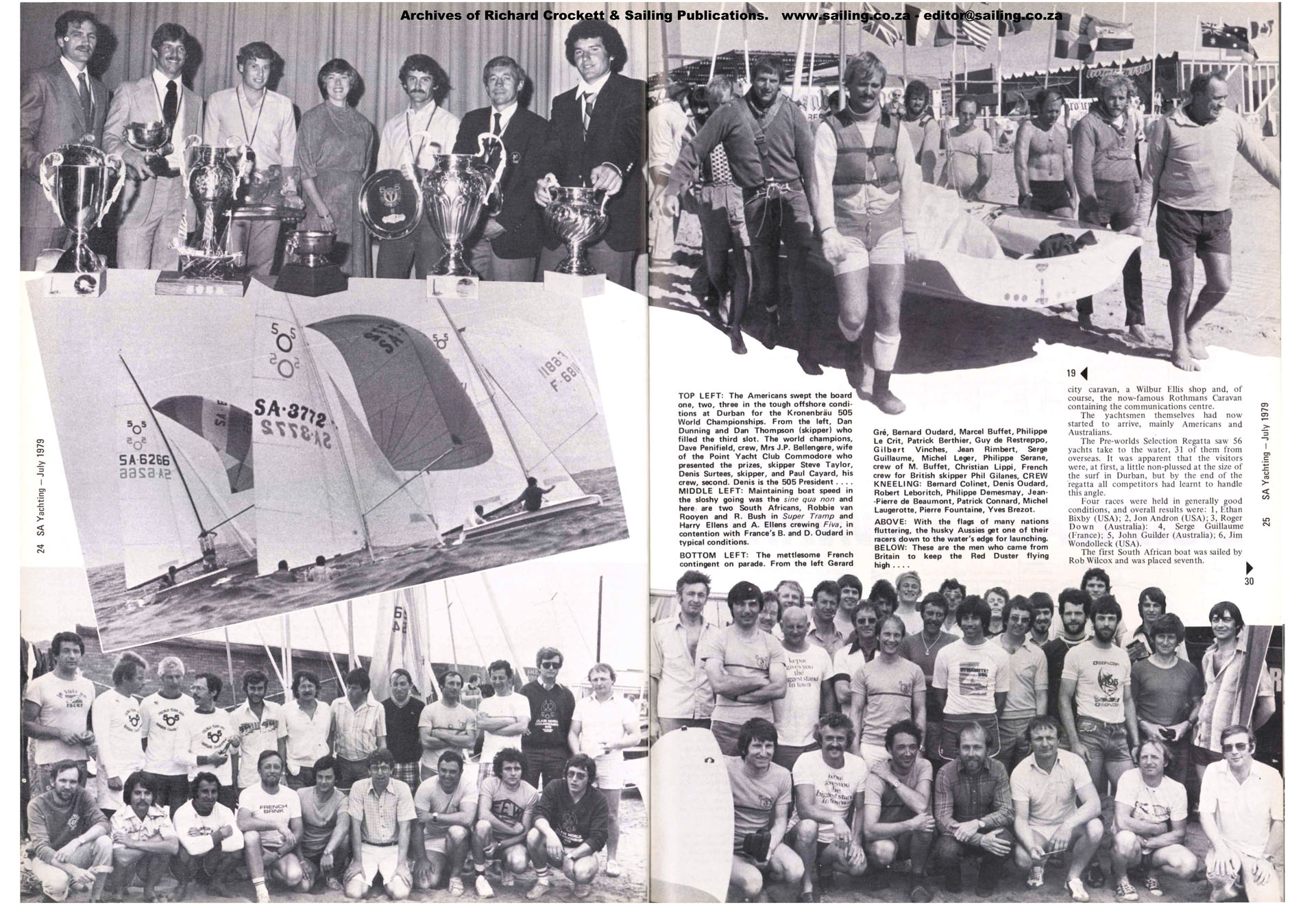
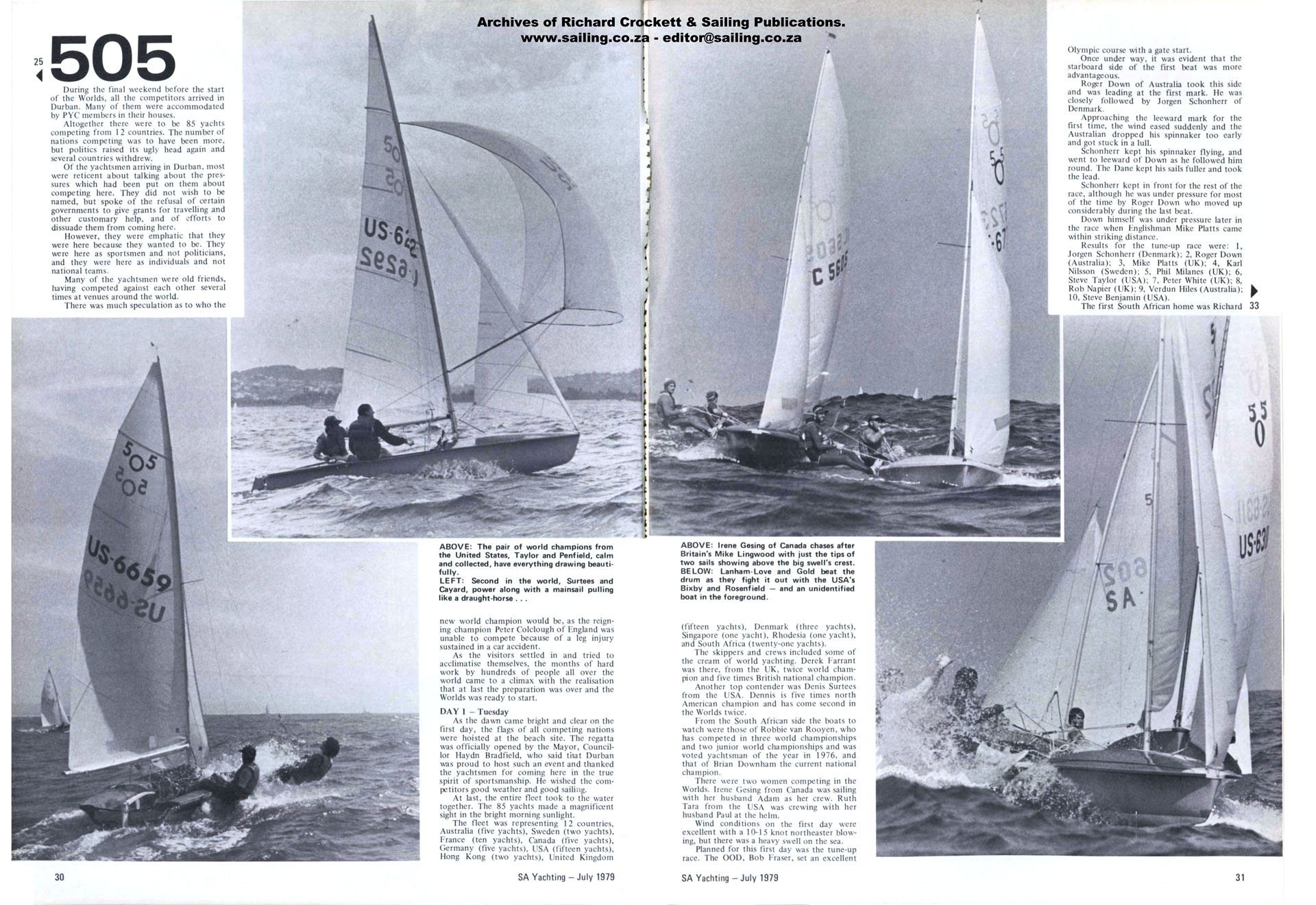
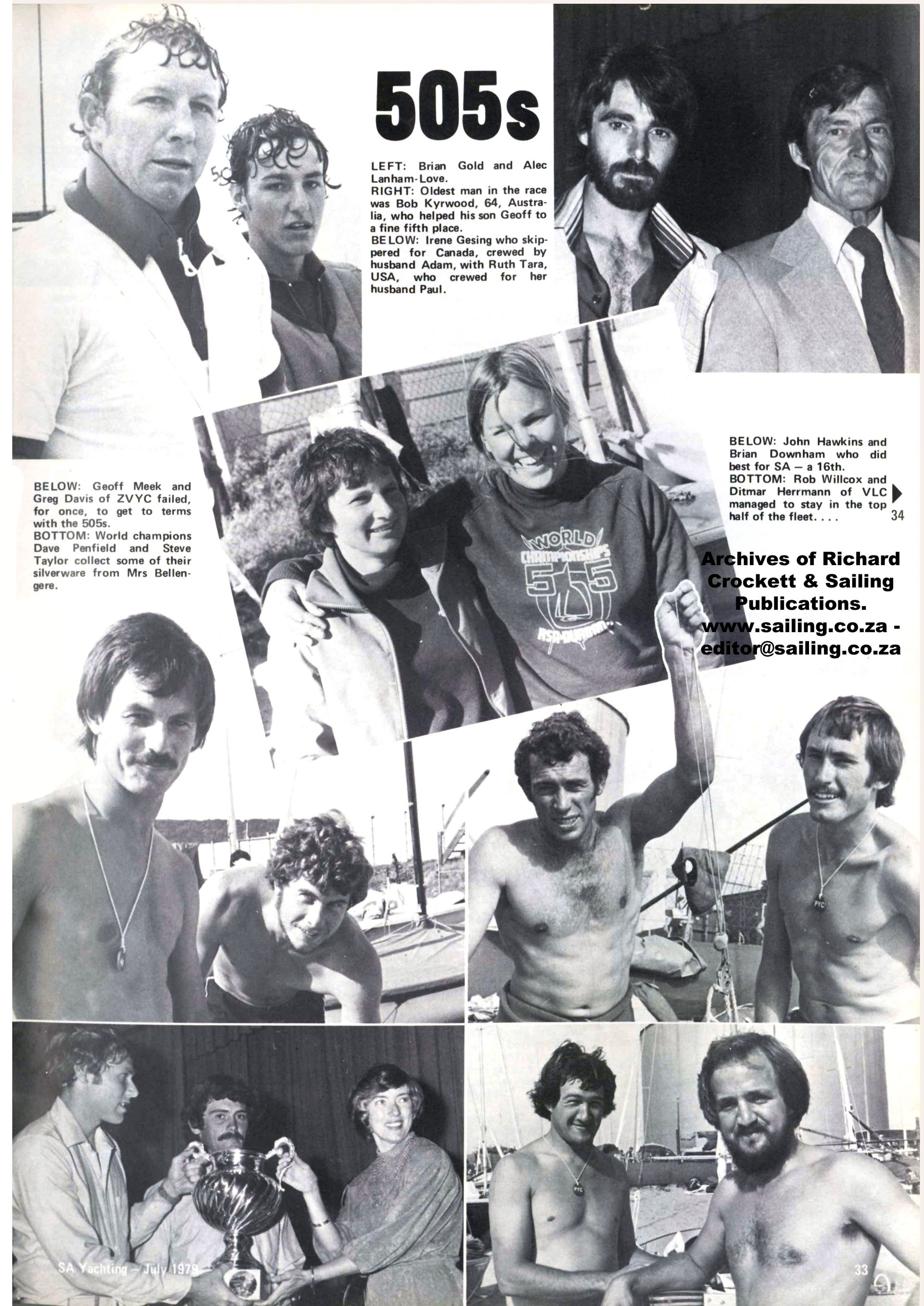
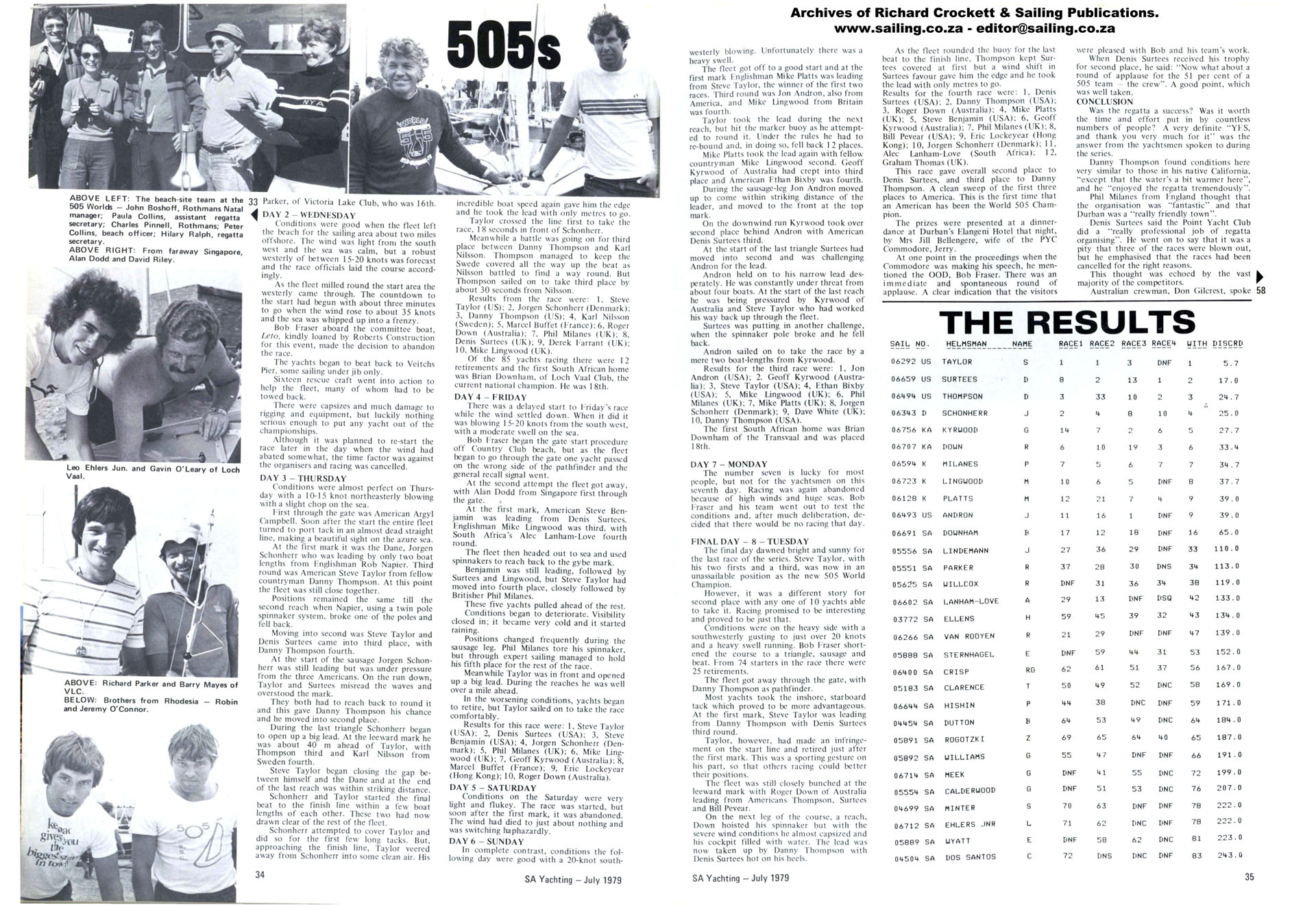
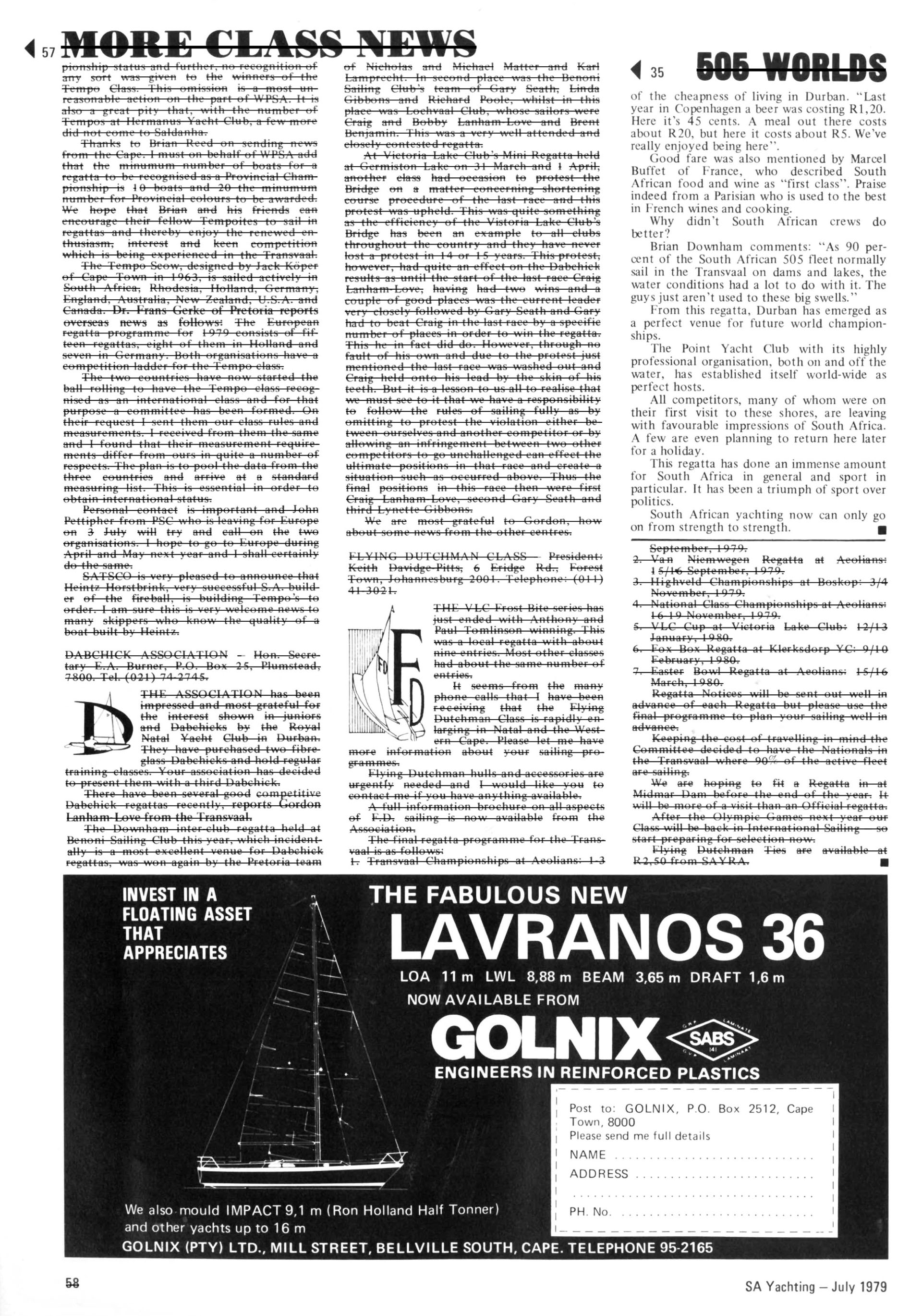
|